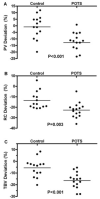The Postural Tachycardia Syndrome (POTS): pathophysiology, diagnosis & management
- PMID: 16943900
- PMCID: PMC1501099
The Postural Tachycardia Syndrome (POTS): pathophysiology, diagnosis & management
Abstract
Postural tachycardia syndrome (POTS), characterized by orthostatic tachycardia in the absence of orthostatic hypotension, has been the focus of increasing clinical interest over the last 15 years 1. Patients with POTS complain of symptoms of tachycardia, exercise intolerance, lightheadedness, extreme fatigue, headache and mental clouding. Patients with POTS demonstrate a heart rate increase of >or=30 bpm with prolonged standing (5-30 minutes), often have high levels of upright plasma norepinephrine (reflecting sympathetic nervous system activation), and many patients have a low blood volume. POTS can be associated with a high degree of functional disability. Therapies aimed at correcting the hypovolemia and the autonomic imbalance may help relieve the severity of the symptoms. This review outlines the present understanding of the pathophysiology, diagnosis, and management of POTS.
Figures






References
-
- Low PA, Opfer-Gehrking TL, Textor SC, et al. Rummans TA. Postural tachycardia syndrome (POTS) Neurology. 1995;45:S19–S25. - PubMed
-
- Wooley CF. Where are the diseases of yesteryear? DaCosta's syndrome, soldiers heart, the effort syndrome, neurocirculatory asthenia--and the mitral valve prolapse syndrome. Circulation. 1976;53:749–751. - PubMed
-
- Miller JW, Streeten DH. Vascular responsiveness to norepinephrine in sympathicotonic orthostatic intolerance. J Lab Clin Med. 1990;115:549–558. - PubMed
-
- Wieling W, Shepherd JT. Initial and delayed circulatory responses to orthostatic stress in normal humans and in subjects with orthostatic intolerance. Int Angiol. 1992;11:69–82. - PubMed
-
- Raj SR, Biaggioni I, Yamhure PC, et al. Renin-aldosterone paradox and perturbed blood volume regulation underlying postural tachycardia syndrome. Circulation. 2005;111:1574–1582. - PubMed
Grants and funding
LinkOut - more resources
Full Text Sources
Other Literature Sources
Medical
